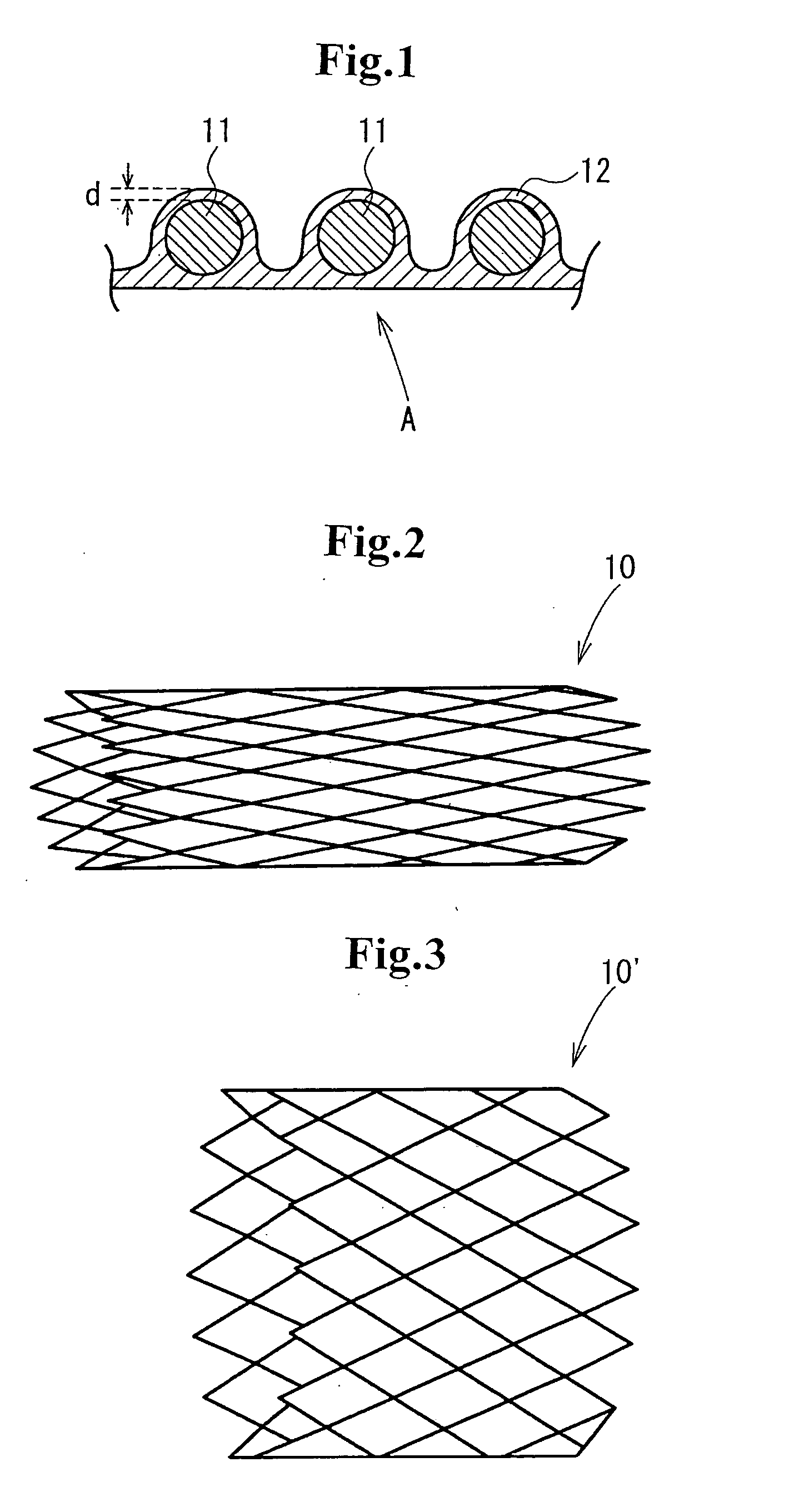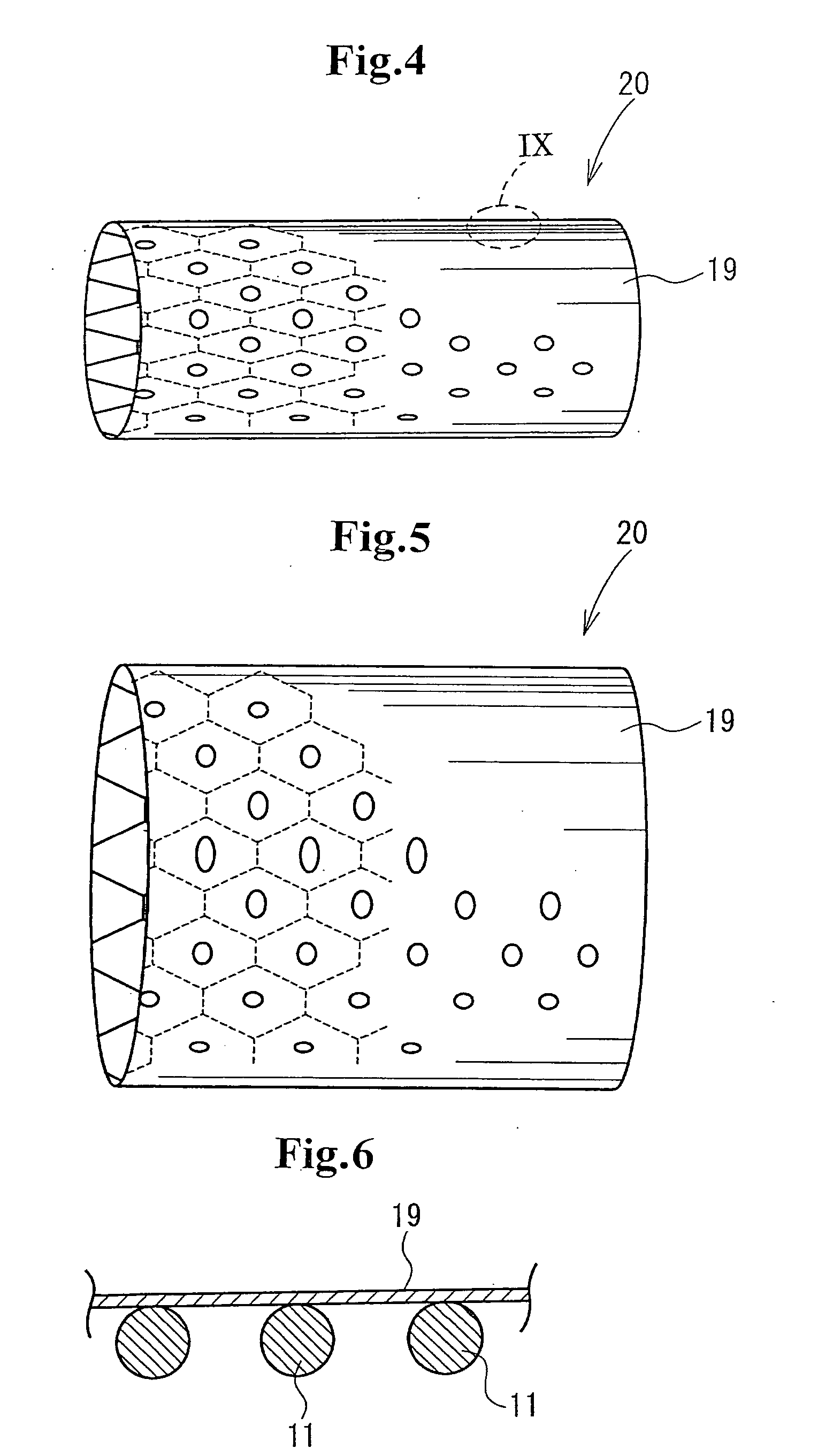Stent and process for producing the same
a technology of intralum and stent, which is applied in the field of intralum stent, to achieve the effects of reducing the formation of thrombosis, reducing the risk of twisting and/or tearing of polymer films, and excellent bendability
- Summary
- Abstract
- Description
- Claims
- Application Information
AI Technical Summary
Benefits of technology
Problems solved by technology
Method used
Image
Examples
example 1
[0089] As the stent matrix, a mesh stent matrix 10 having a diameter of 4 mm, a length of 20 mm, and a thickness of 0.2 mm shown in FIG. 2 was employed.
[0090]FIG. 3 is a perspective view of the metallic stent matrix 10′ after being expanded. The metallic stent matrix 10′ in this state has a diameter of 8 mm, a length of 20 mm, and a thickness of 0.2 mm.
[0091] A stent was produced by coating the entire surfaces of the metallic stent matrix 10 with a segmented polyurethane polymer layer. As described concretely, a mandrel made of SUS316 was impregnated into a polyurethane solution to form a polyurethane layer for coating a cylindrical outer surface of the mandrel. The metallic stent matrix which was slightly expanded was overlaid on the polyurethane layer with significant pressure. The mandrel with the stent matrix was impregnated into the polyurethane solution to form a coating so that both the inner and outer peripheries of the stent matrix were coated. After laser machining, the ...
example 2
[0116] As the stent matrix, a mesh stent matrix 10 having a diameter of 3.2 mm, a length of 20 mm, and a thickness of 0.2 mm shown in FIG. 2 was employed.
[0117]FIG. 3 is a perspective view of the metallic stent matrix 10′ after being expanded. The metallic stent matrix 10′ in this state has a diameter of 8 mm, a length of 20 mm, and a thickness of 0.2 mm.
[0118] A stent was produced by coating the inner periphery and the outer periphery of the metallic stent matrix 10 with segmented polyurethane polymer films 19. As described concretely, a mold having an inner diameter of 3.5 mm was rotated at 6000 rpm and a polyurethane solution was supplied into the mold while moving the injection position along the axial direction of the mold, and heating the polyurethane solution in the mold at 60° C., thereby forming a polymer film as an outer layer having a thickness of 50 μm. After the stent matrix was inserted into the mold, a polyurethane solution was supplied to form a film while rotating...
example 4
[0135] As the stent matrix, a mesh stent matrix 10 having a diameter of 4 mm, a length of 20 mm, and a thickness of 0.2 mm shown in FIG. 2 was employed.
[0136]FIG. 3 is a perspective view of the metallic stent matrix 10′ after being expanded. The metallic stent matrix 10′ in this state has a diameter of 8 mm, a length of 20 mm, and a thickness of 0.2 mm.
[0137] A stent was produced by coating the inner periphery and the outer periphery of the metallic stent matrix 10 with segmented polyurethane polymer films. As described concretely, a mandrel having a diameter of 3.8 mm and made of stainless steel was impregnated into a polyurethane solution, was then pulled up, and was dried so as to form a cylindrical coating of the polyurethane having 30 μm. The metallic stent matrix which was slightly expanded was overlaid on the coating with significant pressure. The mandrel with the stent matrix was impregnated into the polyurethane solution, was then pulled up, and was dried so as to form a ...
PUM
| Property | Measurement | Unit |
|---|---|---|
| Thickness | aaaaa | aaaaa |
| Diameter | aaaaa | aaaaa |
| Diameter | aaaaa | aaaaa |
Abstract
Description
Claims
Application Information
 Login to View More
Login to View More - R&D
- Intellectual Property
- Life Sciences
- Materials
- Tech Scout
- Unparalleled Data Quality
- Higher Quality Content
- 60% Fewer Hallucinations
Browse by: Latest US Patents, China's latest patents, Technical Efficacy Thesaurus, Application Domain, Technology Topic, Popular Technical Reports.
© 2025 PatSnap. All rights reserved.Legal|Privacy policy|Modern Slavery Act Transparency Statement|Sitemap|About US| Contact US: help@patsnap.com



